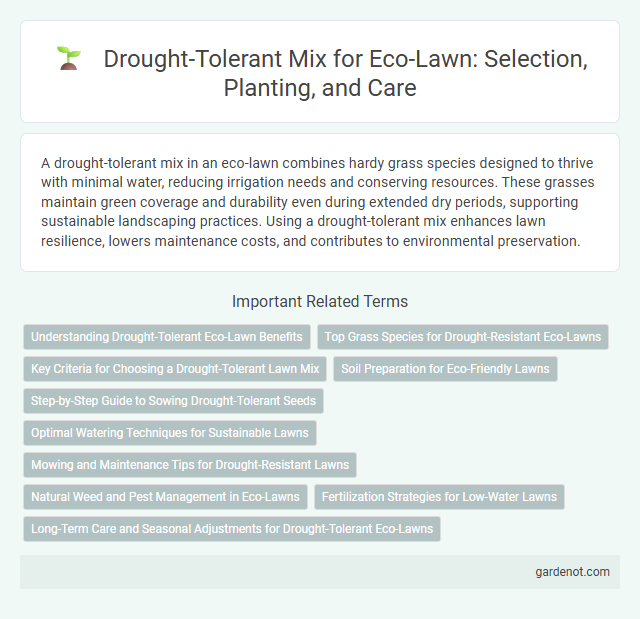A drought-tolerant mix in an eco-lawn combines hardy grass species designed to thrive with minimal water, reducing irrigation needs and conserving resources. These grasses maintain green coverage and durability even during extended dry periods, supporting sustainable landscaping practices. Using a drought-tolerant mix enhances lawn resilience, lowers maintenance costs, and contributes to environmental preservation.
Understanding Drought-Tolerant Eco-Lawn Benefits
Drought-tolerant eco-lawn mixes consist of grass species such as buffalo grass, blue grama, and fescues, which require significantly less water compared to traditional lawns, reducing irrigation needs by up to 50%. These specialized seed blends enhance soil health and promote biodiversity by supporting beneficial microorganisms and pollinators. Implementing drought-tolerant eco-lawns results in increased resilience to dry conditions, lower maintenance costs, and substantial conservation of water resources.
Top Grass Species for Drought-Resistant Eco-Lawns
Drought-tolerant eco-lawns thrive with grass species such as fescue, buffalo grass, and Bermuda grass known for their deep root systems and minimal water requirements. Fine fescue blends, including chewings fescue and hard fescue, offer exceptional drought resistance and low maintenance, making them ideal for eco-friendly landscapes. Incorporating these species into a drought-resistant mix ensures sustained green coverage while conserving water resources in dry climates.
Key Criteria for Choosing a Drought-Tolerant Lawn Mix
Selecting a drought-tolerant lawn mix requires prioritizing grass species with deep root systems such as buffalo grass, bermuda grass, or fine fescues that efficiently access soil moisture. Soil type compatibility and local climate conditions must be considered to ensure optimal water retention and resilience during prolonged dry periods. A blend comprising native grasses and legumes improves drought resistance while minimizing irrigation demands and enhancing overall lawn sustainability.
Soil Preparation for Eco-Friendly Lawns
Drought-tolerant mix for eco-lawns requires well-draining soil enriched with organic compost to retain moisture and promote root growth. Proper soil aeration and pH balance between 6.0 and 7.5 enhance nutrient uptake and drought resilience. Incorporating natural soil amendments like biochar or mycorrhizal fungi improves soil structure and supports sustainable lawn health.
Step-by-Step Guide to Sowing Drought-Tolerant Seeds
Choose a drought-tolerant mix containing native grasses like buffalo grass, blue grama, or fescue for superior water efficiency and heat resistance. Prepare the soil by loosening it to a depth of 4 inches and removing debris to ensure optimal seed-to-soil contact. Sow seeds evenly at the recommended rate, lightly rake to cover, then water consistently but sparingly until establishment, typically within 2 to 3 weeks.
Optimal Watering Techniques for Sustainable Lawns
Drought-tolerant grass seed blends, such as buffalo grass and fine fescue, significantly reduce water requirements for eco-lawns. Applying deep, infrequent watering encourages deep root growth, enhancing drought resilience and soil moisture retention. Monitoring soil moisture levels with sensors ensures precise irrigation, promoting sustainable lawn maintenance while conserving water resources.
Mowing and Maintenance Tips for Drought-Resistant Lawns
Drought-tolerant mix lawns require mowing at higher grass heights, typically around 3 to 4 inches, to shade the soil and reduce water evaporation. Maintenance should include less frequent mowing and leaving grass clippings on the lawn to naturally fertilize and retain moisture. Proper watering strategies involve deep, infrequent irrigation to encourage deep root growth, enhancing drought resistance and overall lawn health.
Natural Weed and Pest Management in Eco-Lawns
Drought-tolerant mixes in eco-lawns utilize native grasses and clover varieties that require minimal water, enhancing resilience during dry periods. These mixes promote natural weed suppression by creating dense turf that limits weed seed germination and growth without chemical herbicides. Pest management is achieved through balanced ecosystems supporting beneficial insects that naturally control pest populations, reducing the need for synthetic pesticides.
Fertilization Strategies for Low-Water Lawns
Drought-tolerant eco-lawns thrive with tailored fertilization strategies that prioritize slow-release nitrogen sources, minimizing water demand and nutrient runoff. Incorporating organic amendments like compost enhances soil moisture retention and nutrient availability, supporting resilient root systems under low-water conditions. Regular soil testing ensures precise nutrient management, optimizing fertilization schedules to sustain healthy growth while conserving water resources effectively.
Long-Term Care and Seasonal Adjustments for Drought-Tolerant Eco-Lawns
Drought-tolerant eco-lawns require minimal irrigation, relying on deep-rooted grasses like Festuca arundinacea and Bouteloua gracilis to withstand prolonged dry periods. Long-term care involves aerating soil annually and applying slow-release organic fertilizers in early spring to maintain soil health. Seasonal adjustments include reducing mowing height in summer to conserve moisture and overseeding in fall to repair drought stress damage.
Drought-tolerant mix Infographic

 gardenot.com
gardenot.com